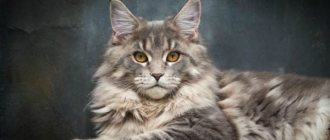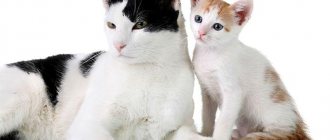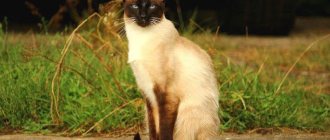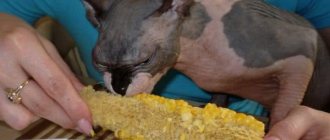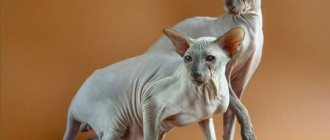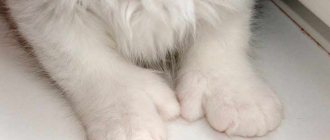Hairless cat breeds appeared not so long ago, so felinologists do not give accurate predictions regarding the age to which such a pet can live at home. It is clear that the life expectancy of sphinxes depends on the conditions of detention, hereditary factors and veterinary care. This means it’s worth learning how to provide proper care and comfortable living so that the cat will delight its owner with its presence for many years.
How long do Sphynx cats live?
At home, sphinxes live no more than 15 years, but the average is usually 10-12 years. This was not always the case, and on the way to becoming these unique cats they had to go through all stages of selection. The first animals lived for about 10 years and died without becoming the ancestors of hairless cats due to insufficient fertility (ability to reproduce) within the group. Later, experimental Don Sphynxes showed that they definitely live up to 10 years.
This is interesting! The Don and Canadian sphinxes have a different genetic mutation. The first ones lost their hair as a result of the hr gene, and the Russian cat has a longer formula - Hrbd.
Factors affecting health
The lifespan of a cat largely depends on its health. It is easier to prevent a disease than to treat it. Therefore, felinologists recommend that Sphynx owners closely monitor their pets and, when the first alarming symptoms appear, show the animal to a veterinarian.
To raise a strong pet, you need to pay attention to the following factors:
- Conditions of detention. The well-being of sphinxes instantly responds to unsanitary conditions and unsatisfactory temperature conditions in the room. Hairless cats have an increased body temperature due to their active metabolism, so they are prone to colds.
- Communication. Sphinxes do not like loneliness and often become stressed without the attention of their owner. Veterinary practice has proven that in a depressed state, hairless cats are more susceptible to developing diseases.
All sphinxes have a high degree of development of nervous organization. They cannot be approached with the standards of other cat breeds. Any deviation from the norm first leads to worsening mood, apathy, loss of appetite and further to the development of physical diseases.
Features of feeding and diet
The cost of keeping the Don Chak is high due to its appetite. To heat up, a bald body requires more energy, so the metabolism works at an accelerated pace. An adult animal will have to be fed 3-4 times a day.
The basis of the diet is meat. A cat should eat 150 g of meat products per day. Twice a week the meat is exchanged for boiled offal, and twice a month - for boiled sea fish, cleaned of bones. The rest of the natural diet consists of the following products:
- cereals;
- vegetables;
- fermented milk products.
All food must be fresh. If you don't have time to cook, then use dry food. Many manufacturers have special lines designed for Sphynx cats. For your pet’s health, choose super premium or holistic food. They contain higher quality ingredients and do not cause stomach upset.
How to extend your pet's life
Sphynxes are special cats. They do not have immunity developed over centuries, and their character was formed under the influence of artificial selection. Such animals cannot exist without humans, and even at home they require special care.
Regular and timely prevention of diseases in sphinxes
At 9-12 weeks, the Sphynx kitten should be vaccinated against the following diseases for the first time:
- rabies;
- chlamydia;
- rhinotracheitis;
- panleukopenia;
- calcivirus
Then, within a month, another vaccination is carried out (except for rabies) and then the procedure is repeated annually. If the epidemiological situation in the region is unfavorable for a number of other diseases (for example, ringworm), then the appropriate preventive components are added to the vaccination kit.
How many years does a Sphynx cat live, how many stages of vaccination should it receive? It is completely unacceptable to refuse procedures due to home confinement. For example, chlamydia is transmitted not only through sexual contact or during childbirth from a sick mother, but also through food. The only way to protect yourself from this disease and extend your cat’s life is with a vaccine.
Important! Due to the lack of hair, Canadian and Don Sphynxes, like other hairless cats, are contraindicated in temperature changes and drafts.
Proper feeding
Experts call nutrition a universal tool for maintaining health and increasing life expectancy. Due to the lack of fur, hairless cats have a faster metabolism and increased appetite, so the owner must strictly control the portion size for the Sphynx. This is especially true for castrated cats. And excess weight has a negative impact on the activity of the kidneys, heart and blood vessels, and, accordingly, on the life expectancy of the pet.
Manufacturers of ready-made mixtures produce formulations specifically for hairless animals. They take into account the recommended serving size and maintain the ratios of proteins, fats and carbohydrates.
Important! The correct choice of food has an absolute impact on how long Sphynx cats live. The main danger lies not in industrial products, but in the desire of a gluttonous pet to eat all the leftovers from the owner's plate. Here he may come across ingredients that are unacceptable for health - potatoes, tomatoes, sausage, pasta and sweets.
Hygiene and care
Sphynx cats have no fur, which means there is no need for regular brushing. Standard cat care consists of several simple steps:
- You can wipe your animal weekly with a damp cloth - a worthy replacement for bathing.
- Clean the area around the eyes - due to the lack of eyelashes, mucus can accumulate here.
- Trim the claws and treat the skin around them - make sure there are no wounds, which often appear in these places.
- Use a cotton swab to clean the open inner surface of the ears, and use special drops for deep treatment of the ear canal.
Education and physical activity
Sphynx cats are active cats. They are always ready for outdoor games with people or pets. Hairless cats rarely go outside, so owners have to organize space for active pastime in the apartment.
Physical activity for all types of sphinxes must correspond to the age of the pet:
- As a child, the Sphynx demonstrates irrepressible energy.
- Reaching sexual maturity somewhat reduces activity, but between playing and relaxing on the couch, the Sphynx will always choose the former.
- As you get older, your temperament changes. The cat becomes calmer, sleeps for a long time and loses interest in outdoor games.
Limiting stress factors
In general, all representatives of hairless sphinxes have a strong nervous system and are not inclined to fall into emotional depression. But a state of constant stress will definitely affect the pet’s immunity, character and behavior. Owners need to constantly monitor the situation, especially when there are other animals or children in the house.
Sterilization and castration
Sphynx castrati (boys or girls) do not experience sexual desire and do not have offspring. Such cats live 3-5 years longer than animals that have preserved sexual functions.
The lifespan of sterilized Sphynx cats is the same as that of regular cats. After the operation, they lose the ability to reproduce, but the production of sex hormones remains.
Important! If owners do not plan to use hairless pets for breeding, it is recommended that all types (breeds) of Sphynx be sterilized or castrated.
Should I worry?
Of course, every pet owner who is sincerely attached to his four-legged friend sooner or later asks this question, because the death of a pet for the whole family is a very sad event and everyone wants to know exactly when to be prepared for it.
If there are children in the family, this issue becomes even more acute. For a small child, the death of an animal can be not just a sad incident, it can really seriously hit a fragile psyche and lead to irreparable consequences, so the question of whether to give a child a kitten is quite logical.
In fact, you just need to understand that most health problems in cats arise from poor diet. Most of the diseases that shorten a pet’s life are the result of an unbalanced or simply incorrectly selected diet.
Representatives of the Sphynx breed in this regard are no different from all other domestic animals. They need proper care, constant care, proper nutrition. If you follow the simplest and most obvious rules, the cat will live next to its owner for a very long time.
Famous long-lived sphinxes
High-quality cat care, veterinary care and feeding allow for an increase in its lifespan. If an animal comes to its owner as a child, its chances of seeing extreme old age increase significantly - when Don (Canadian) Sphynx kittens live in one place and get used to the environment, they are less susceptible to psychological stress.
Nature has given bald pets 10 to 15 years of life. Although some cats have already significantly exceeded this limit.
The story of the most famous long-lived sphinx named Granpa Rex Allen is very remarkable. He was born as a result of one of the first experimental matings. His parents were a Canadian Sphynx and a Devon Rex. The cat lived a record 34 years plus another 60 days. At the moment, this sphinx is one of the few whose age is recorded in the Guinness Book of Records. After Grandp's death, Rex Allen received the title of "Cat of the Year" from the authoritative publication "Cats and Kittens" (1999).
The owner of the Sphynx subsequently raised another record-breaking cat. She became Cream Puff, who outlived her predecessor by as much as 4 years. They say that Jake Perry (the owner of these centenarians) offered his pets some unique menu and showed films with beautiful views and exotic landscapes.
Good heredity, activity and a comfortable home environment are excellent help for the long life of sphinxes. And the attention of the owner, timely assistance from veterinarians and high-quality food only complement the list of things necessary to reach old age.
Origin story
Historians have confirmed the fact that the Aztecs (an Indian people living in Mexico in the 14th-16th centuries) had hairless cats. They are known as the Mexican Hairless, but were different from modern Sphynxes. They had large amber-colored eyes, a wedge-shaped head, and long mustaches. And by winter, wool grew, which disappeared with the onset of warmth. However, in the 30s. 20th century The Mexican hairless has disappeared.
The history of the Canadian breed begins in 1966, when an ordinary domestic cat, Elizabeth, gave birth to a hairless kitten. This happened in Ontario (Canada). The baby was named Prune or Prune because his body was wrinkled. When he grew up, he was crossed with his mother. Some of the offspring had fur, some did not. Pruna had to be crossed with his closest relatives (daughters, granddaughters) in order to secure hairlessness. This was the path to the degeneration of the breed.
The situation was saved in 1975 by the discovery of another hairless cat in Minnesota. Because of its unusual appearance it was called Epidermis. It was this cat that became the “father” of all the elite lines of Canadian Sphynx cats that are known today. Also in the 70s, 2 more hairless cats were found in Toronto. They ended up in Holland and became the founders of the European variety. Their names were Paloma and Pinky.
In order for the breed to develop, breeders crossed hairless cats with Devon Rex cats that matched the type and appearance. However, the influx of Devon blood had negative consequences - the Sphinx breed began to degenerate. From such a connection, cats became too fragile, their eyes were round, their skin was thin. And most importantly, the folds have almost disappeared. Sphinxes are no longer wrinkled. Therefore, now animals with a large number of folds, without mustaches and eyebrows, are very valuable.
After the first exhibition, Sphynx breeders were sued for cruelty to animals - they “stripped” the cat too much. When more information became available that the lack of hair was the result of a natural mutation and not genetic engineering, the breed began to be perceived as normal.
It was only in 2002 that the Cat Fanciers Association officially accepted the Sphynx. Then recognition came from CFA, ACFA, TICA.
What does life expectancy depend on?
Unfortunately, the life of pets is not as long as many owners would like, and Sphynxes are no exception. There are many factors that can prolong or, conversely, shorten the lifespan of these animals. Let's look at the most basic ones.
First of all, experts advise keeping your pet’s weight under control. Cats can overeat if left unchecked, which can ultimately lead to obesity and related problems.
You should choose healthy foods and carefully consider your diet so that it contains the necessary nutrients and vitamins in the required quantities.
Another important factor is cleanliness. This is due to the fact that the cat has practically no hair; accordingly, a specific fatty layer forms on its body, on which bacteria can multiply. Therefore, water procedures are necessary and should be carried out every day.
It would also be useful to use special cleaning compounds.
Cats of this breed also lack protective hairs in the ears, which leads to the active formation of wax. To eliminate wax plugs, which are very harmful to your pet, the ears will need to be cleaned every week.


